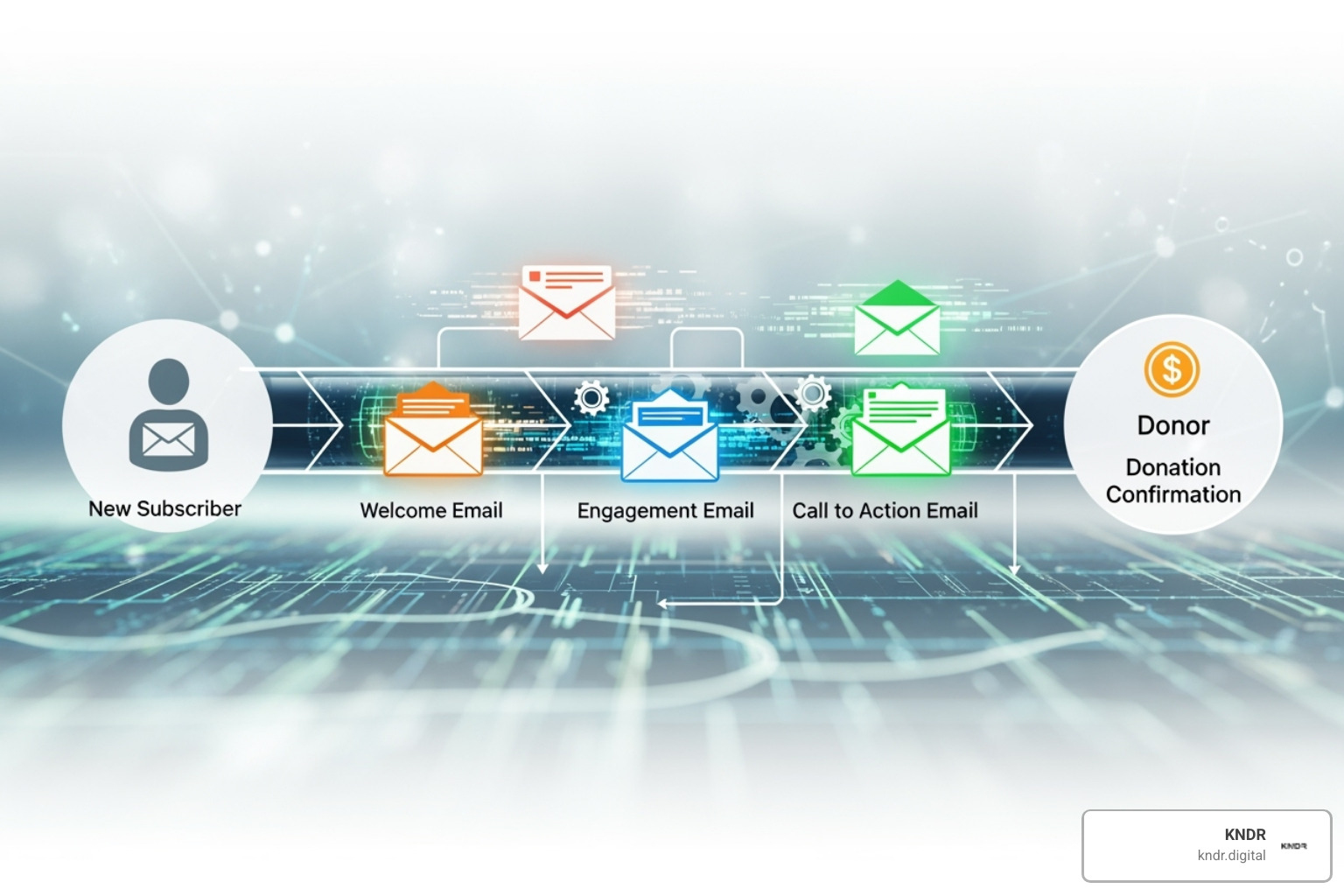Beyond Bake Sales: Digital Marketing for Nonprofits That Works

Why Digital Marketing Is Essential for Modern Nonprofits
Nonprofit digital marketing is the strategic use of online channels to raise awareness, engage supporters, and drive donations. Unlike traditional methods, it offers unprecedented reach, cost-effectiveness, and the ability to connect with supporters based on their interests.
Key Components of Nonprofit Digital Marketing:
- Website optimization and search engine optimization (SEO)
- Email marketing for donor communication and fundraising appeals
- Social media marketing for community building and storytelling
- Paid advertising including Google Ad Grants and social media ads
- Content marketing to educate and inspire supporters
- Marketing automation to streamline outreach and donor journeys
The data shows why nonprofits must accept digital channels. Email-based marketing generates around 28% of all online nonprofit revenue, and SMS marketing has an open rate of over 98%, compared to just 20% for emails. With online giving accounting for 13.4% of small nonprofits' total revenue and search ads returning $4.78 for every dollar spent, digital marketing is essential for survival and growth.
Digital marketing levels the playing field, allowing small nonprofits to reach global audiences and build meaningful relationships at a fraction of the cost of traditional methods.
I'm Mahir Iskender, CEO of KNDR.digital. I help mission-driven organizations scale with AI-powered marketing and digital fundraising systems. I've seen how the right digital strategy transforms stagnant donations into sustainable growth while reducing workloads through smart automation.

Crafting Your Winning Digital Marketing Strategy
In our digital-first world, an online presence is essential for nonprofits. The good news is you don't need a massive budget to make an impact. Digital marketing offers lower costs, faster results, and the ability to reach people who genuinely care about your cause.
Think of your digital strategy as a roadmap. It's not about being everywhere online—it's about being strategic. When all your digital efforts work together, every email, social post, and website update amplifies your message. A thoughtful plan ensures every online effort aligns with your core mission. At KNDR, we've helped countless organizations build these foundations, which is why we created our comprehensive guide on KNDR's nonprofit marketing strategy insights.
Step 1: Set SMART Goals and Define Your KPIs
Before you begin, you need to know what you're trying to achieve. SMART goals are your best friend here: Specific, Measurable, Attainable, Relevant, and Time-based. They provide focus in a chaotic digital world.
Instead of a vague goal like "we want more donations," a SMART goal would be "we'll increase online donations by 25% over the next six months." This gives you a clear target and deadline.
Your Key Performance Indicators (KPIs) are your organization's vital signs, showing what's working and what needs attention. Common KPIs include email open rates, conversion rates (the percentage of website visitors who donate), donor retention rates, and campaign ROI. Checking these numbers regularly allows you to make smart adjustments instead of guessing. Dive deeper into setting effective nonprofit digital marketing goals to ensure you're tracking what matters most.
Step 2: Segment Your Audience for Personalized Impact
Generic messages get ignored. With overflowing inboxes, personalization is necessary to break through the noise. Audience segmentation involves organizing supporters into smaller groups based on commonalities, allowing you to tailor your message to each group's interests and motivations.
For example, you can send volunteer opportunities to past volunteers and program-specific appeals to donors who've supported similar initiatives. This targeted approach feels more personal and yields better results. You can segment your audience using demographics (age, location), engagement history (past donations, event attendance), or psychographics (values, interests).
Creating donor personas—detailed profiles of your ideal supporters—takes this a step further. These fictional characters help you craft messages that truly connect. By sending relevant content, you show supporters you value their time and understand their interests. Check out our guide on donor segmentation best practices to master this skill.
Step 3: Choose Your Channels and Build Your Message
Decide where to show up online and what to say. The key is meeting your audience where they already spend their time. Multichannel marketing means being present across multiple platforms, but strategically. Younger supporters might be on Instagram and TikTok, while older donors may prefer email. Focus on the channels where your audience is most active.
Once you've picked your platforms, craft messages that move people to action. Compelling storytelling is your secret weapon. Share real stories about the people you help, show the tangible impact of donations, and highlight your volunteers. Visuals are crucial, as a powerful photo can communicate more than paragraphs of text.
Don't forget your call-to-action (CTA). Every piece of content should guide people toward a specific next step, like "Donate Now" or "Sign Up to Volunteer." Consistency in your voice, values, and visual style builds trust and reinforces your brand. Our nonprofit storytelling framework can help you create narratives that inspire action.
Step 4: Track, Analyze, and Optimize
Success in nonprofit digital marketing comes from continuous improvement. Performance monitoring is like your organization's fitness tracker; you need to check your vital signs regularly. If email open rates are strong but click-through rates are weak, your subject lines are working, but your content needs improvement.
Data analysis reveals patterns and opportunities. If social media posts get high engagement but don't drive website traffic, you may need stronger CTAs. A/B testing is like conducting mini-experiments. Test two different email subject lines or donation page layouts to see which performs better. These small tests can lead to significant improvements.
The goal is to get better with each campaign. By consistently evaluating your campaign ROI and adapting based on data, your marketing becomes more effective and efficient. This cycle of tracking, analyzing, and optimizing is continuous, meaning you're always improving your ability to connect with supporters.
Core Channels for Nonprofit Digital Marketing
Successful nonprofit digital marketing weaves multiple channels together, creating a seamless journey for supporters. Think of each channel as a different conversation starter. When your website, social media, email, and paid ads work in harmony, you can transform scattered efforts into powerful impact. For a comprehensive look at bringing these pieces together, dive into our guide on Multichannel marketing.

Your Website & SEO: The Hub of Your Digital Presence
Your website is your digital home base, where all other marketing efforts should lead. It's where visitors can learn about your mission and take action. Since mobile phones account for over half of all internet traffic, your site must be mobile-friendly. If it isn't, you're turning away half your audience.
Site speed is also critical. Research from Google shows that as page load time goes from 1 to 3 seconds, the probability of someone leaving increases by 32%.
This is where search engine optimization (SEO) becomes a major opportunity. When someone searches for "homeless shelter near me," you want to appear at the top. Good SEO starts with keyword research to understand what your supporters are searching for. Then, use content creation to publish helpful articles and success stories that answer their questions. This positions you as a trusted source and improves your search ranking. Don't forget to optimize your donation pages; our insights on Landing Page Optimization for Non-Profit Organization Success can help.
Email Marketing: Your Direct Line to Supporters
Email marketing is like having a one-on-one conversation. It's thriving, with 33% of online donors saying email is the tool that most inspires them to give. The beauty of email lies in its intimacy and incredible return on investment. When someone opens your email, you have their full attention.

Your email strategy should focus on building relationships. Use newsletters to keep your community updated, and craft fundraising appeals with compelling stories. Thank-you emails are an underrated tool for building lasting relationships, while impact reports show supporters how their contributions made a difference. Aim for two to four emails per month to stay top-of-mind without overwhelming inboxes. Ready to improve? Check out our strategies for Boosting Nonprofit Donations through smart email marketing.
Social Media: Building Community and Driving Donations
Social media is a must-have for building community. While organic follower growth rates are modest (between 0.64% to 3% per month), strategic social media still delivers powerful results.
Each platform has unique strengths. Facebook and Instagram excel at visual storytelling and targeted advertising. LinkedIn is ideal for corporate partnerships and professional audiences. YouTube is perfect for longer-form content like testimonials and virtual tours.
Since 29% of online donors say social media inspires them to give, create content that moves people. Encourage user-generated content by having supporters share their own stories. Make social sharing easy to amplify your message through trusted networks. And consider influencer outreach with local community leaders or passionate volunteers. For deeper strategies, explore KNDR's social media tips for nonprofits.
Paid Advertising: Amplifying Your Reach with Digital Grants
While organic marketing builds your foundation, paid advertising acts as a megaphone. You can target people based on their interests, behaviors, and recent online activity.
The crown jewel for nonprofits is the Google Ad Grant, which provides up to $10,000 per month in free Google search advertising. This allows you to appear at the top of search results for relevant keywords without touching your fundraising budget. The return is remarkable, with search ads bringing in $4.78 for every dollar spent.
Social media advertising on platforms like Facebook and Instagram allows for incredibly detailed targeting. Retargeting campaigns are especially powerful, gently reminding people who visited your donation page but didn't complete the gift, often recapturing 20-30% of those opportunities.
| Organic Reach | Paid Advertising |
|---|---|
| Free but requires time and effort | Costs money but delivers immediate results |
| Builds long-term community and trust | Drives specific actions like donations |
| Limited control over who sees your content | Precise targeting and full control |
| Gradual, sustainable growth | Rapid visibility and scalable impact |
The smartest nonprofits use both. Ready to open up the power of digital advertising? Our KNDR's guide to digital ad grants will walk you through it.
Level Up: Advanced Tactics for Efficiency and Impact
Once you've mastered the basics, it's time to boost your nonprofit digital marketing with advanced tactics. These strategies are about working smarter, maximizing your impact, and building a future-proof approach.
Marketing Automation: Work Smarter, Not Harder
Nonprofit teams are stretched thin. Marketing automation handles repetitive tasks so your team can focus on what matters most. It's like having a tireless team member who always sends the right message at the right time.

Use automated email streams to welcome new subscribers and guide them toward their first donation. Create personalized journeys based on supporter actions—a volunteer gets different messages than a first-time donor. This level of personalization is effortless with automation.
Donor nurturing becomes incredibly efficient. An automated sequence can remind someone to complete an abandoned donation form or send a well-written volunteer thank-you letter after their first shift. At KNDR, we've seen how AI-Driven Fundraising systems can transform small teams into fundraising powerhouses by automating what used to take hours of manual work.
SMS Marketing: Cut Through the Noise
Email inboxes are crowded, but text messages get noticed. With an open rate of over 98% compared to email's 20%, SMS marketing cuts through the digital noise. It feels personal and immediate, but this power comes with responsibility—use it wisely.
Text-to-give campaigns are perfect for live events or emergency appeals. Quick announcements work well for urgent updates. Event reminders sent via SMS dramatically boost attendance rates. Our guides on SMS marketing and text-to-give can help you implement this high-impact channel. Use SMS to complement your other channels for moments when immediate attention is crucial.
Common Pitfalls to Avoid in Your Nonprofit Digital Marketing
Even well-intentioned nonprofits can stumble. Knowing what to watch for can help you avoid common mistakes.
- Inconsistent branding: When your logo, colors, and voice differ across platforms, it erodes trust. Consistency builds recognition.
- Ignoring data: Don't rely on gut feelings. Track your KPIs and let the numbers guide your decisions.
- Poor mobile experience: Over half of your supporters will visit your site on mobile. Ensure your website and donation forms are easy to use on a small screen.
- Not thanking donors: A prompt thank-you shows your gratitude and confirms their gift was received. Make gratitude a priority.
- Neglecting SEO: If potential supporters can't find you via search, you're invisible. Invest time in optimizing your website.
- Generic communication: Treat supporters as individuals. Use segmentation and personalization to build lasting relationships.
For more insights on avoiding these mistakes, explore our guide on Charity Digital Marketing.
Frequently Asked Questions about Nonprofit Digital Marketing
Here are answers to the three most common questions we hear from nonprofit leaders at KNDR.
How much should a nonprofit budget for digital marketing?
There's no magic percentage that works for every organization; your budget depends on your size and goals. However, digital marketing is often far more cost-effective than traditional methods.
- Digital ad grants can transform your budget. Eligible nonprofits can access the Google Ad Grant, providing up to $10,000 per month in free Google Ads. That's $120,000 in advertising value annually.
- Digital channels offer remarkable ROI. Search ads return $4.78 for every dollar spent, and email marketing generates around 28% of all online nonprofit revenue.
Our advice is to start small and focus on ROI. Pick one or two channels, measure your results, and reinvest your returns into expanding your efforts. Remember to factor in staff time for "free" channels like organic social media.
How can a small nonprofit with a tiny team manage digital marketing?
The secret is prioritization and smart automation. You don't need to be everywhere online; doing a few things well is better than doing everything poorly.
- Focus on one or two key channels where your audience is most active.
- Use automation tools to handle repetitive tasks like welcome emails and donor thank-yous. These systems work 24/7, freeing up your team.
- Leverage passionate volunteers for tasks like content creation or social media management.
- Use templates and user-friendly tools to maintain a professional look without needing design expertise.
Consistency over perfection is key. A simple, authentic story shared regularly often outperforms an elaborate, resource-draining campaign.
How long does it take to see results from digital marketing?
Different channels work on different timelines. Setting realistic expectations is crucial.
- Paid advertising delivers the fastest results. You can see traffic and potential donations within days, making it perfect for urgent campaigns.
- Email marketing offers mid-term results. You'll see engagement within 24-48 hours of sending a campaign, but building a robust email list takes months.
- SEO and content marketing require patience. It typically takes 3-6 months of consistent effort to improve search rankings and build organic traffic. This is a long-term strategy.
- Social media growth is gradual. Building an engaged community takes sustained effort over several months.
The most successful nonprofit digital marketing strategies combine quick wins from paid ads with long-term relationship building through SEO and email. This balanced approach ensures both immediate results and sustainable growth.
Conclusion
We've covered the roadmap for changing your outreach with nonprofit digital marketing. The key strategies—setting SMART goals, segmenting your audience, and choosing the right channels—are proven methods to amplify the incredible work you're already doing.
Digital channels offer unprecedented reach and cost-effectiveness. When search ads return $4.78 for every dollar spent and email generates 28% of online revenue, the numbers speak for themselves. The future is digital, and the nonprofits that thrive tomorrow are the ones investing in these strategies today.
At KNDR, we've seen how the right digital strategy transforms stagnant donations into consistent growth while reducing your team's workload through smart automation. Our AI-driven systems are designed to streamline fundraising for mission-driven organizations like yours. We're so confident in our approach that we promise 800+ donations in 45 days, or you don't pay.
Building strong supporter relationships through digital channels creates meaningful connections at scale. Don't let your mission be limited by outdated methods. The tools and strategies we've discussed are within your reach.
Ready to take the next step? Contact Us today, and let's discuss how we can amplify your impact through strategic digital marketing.


